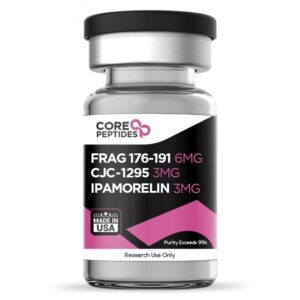Description
CJC-1295 & Ipamorelin Peptide Blend – Long Description
Overview
The combination of CJC-1295 and Ipamorelin is a synergistic peptide blend designed to enhance endogenous growth hormone (GH) secretion by targeting different mechanisms in the anterior pituitary. Both peptides are classified as growth hormone secretagogues (GHSs). CJC-1295 mimics the action of growth hormone-releasing hormone (GHRH), while Ipamorelin selectively targets the growth hormone secretagogue receptor (GHS-R1a), also known as the ghrelin receptor. This dual approach is theorized to amplify GH pulsatility and sustain elevated levels of insulin-like growth factor 1 (IGF-1), which mediates many anabolic effects in tissues.
Peptide Composition and Chemistry
| Peptide | Amino Acids | Molecular Formula | Molecular Weight | Other Names |
|---|---|---|---|---|
| CJC-1295 | 29 (tetrasubstituted) | C152H252N44O42 | 3367.9 g/mol | CJC-1295 NO DAC; Modified GRF 1-29 |
| Ipamorelin | 5 (pentapeptide) | C38H49N9O5 | 711.8 g/mol | NNC 26-0161 |
-
CJC-1295 includes four amino acid substitutions (positions 2, 8, 15, and 27) to enhance stability against enzymatic degradation, increase half-life, and improve receptor affinity.
-
The DAC component (when included) binds to plasma proteins, extending peptide persistence and maintaining GH release.
-
Ipamorelin selectively activates the GHS-R1a receptor in somatotrophs without stimulating other pituitary hormones like prolactin, minimizing off-target effects.
Mechanism of Action
-
CJC-1295
-
Binds GHRH receptors on somatotroph cells in the anterior pituitary.
-
Triggers conformational changes that activate G-proteins, inducing secondary messengers such as cAMP and IP3.
-
Activates protein kinases that phosphorylate transcription factors, influencing genes involved in GH synthesis.
-
Sustained GH release stimulates IGF-1 production in liver and peripheral tissues, supporting anabolic and regenerative functions.
-
-
Ipamorelin
-
Binds selectively to GHS-R1a receptors on pituitary and hypothalamic cells.
-
Activation of Gαq/11 proteins stimulates phospholipase C (PLC), generating IP3 and DAG.
-
IP3 increases calcium release from the endoplasmic reticulum; DAG activates protein kinase C (PKC).
-
These cascades facilitate GH exocytosis without affecting other anterior pituitary hormones.
-
-
Synergistic Action
-
Ipamorelin triggers rapid GH release within 1–2 hours post-administration.
-
CJC-1295 maintains prolonged GH elevation, creating a sustained pulsatile pattern.
-
The blend may enhance GH-mediated effects, including increased muscle protein synthesis, improved nitrogen balance, and positive lean mass gain.
-
Pharmacokinetics
| Peptide | Half-Life | Duration of Action |
|---|---|---|
| Ipamorelin | ~2 hours | Short-acting, rapid onset |
| CJC-1295 (No DAC) | 30 minutes | Moderate GH elevation; single-dose effect 1–3 days |
| CJC-1295 (DAC) | 5.8–8.1 days | Sustained GH elevation; long-lasting IGF-1 increase |
-
When combined, Ipamorelin initiates GH release while CJC-1295 sustains it over a prolonged period.
-
This combination has been observed to increase GH secretion by 46–75% and IGF-1 levels by ~45% on average in clinical models.
Physiological Effects
-
Muscle Hypertrophy: GH and IGF-1 stimulate fibroblast and myocyte proliferation, supporting lean tissue growth.
-
Fat Metabolism: Enhanced lipolysis through GH-mediated pathways, potentially reducing adipose tissue.
-
Bone Health: IGF-1 promotes osteoblast activity, enhancing bone density.
-
Cellular Anabolism: Positive nitrogen balance, increased urea cycle efficiency, and support for organ protein synthesis.
-
GH Pulsatility Restoration: Mimics natural endocrine rhythms, improving metabolic and physiological outcomes.
Research Findings
-
Clinical trials demonstrate Ipamorelin’s rapid GH induction with short half-life, while CJC-1295 extends GH release.
-
Studies suggest CJC-1295 may stimulate somatotroph cell proliferation, increasing pituitary RNA and GH mRNA expression.
-
The peptide blend is under investigation for lean mass improvement, tissue regeneration, metabolic support, and aging-related research.
-
Positive nitrogen balance studies indicate potential improvements in protein metabolism and anabolic efficiency in experimental models.
Applications
-
Research in GH deficiency, aging, sarcopenia, and metabolic disorders.
-
Studying anabolic effects on muscle, bone, and connective tissue.
-
Investigating GH pulsatility restoration and IGF-1-mediated cellular regeneration.
Important Note: This peptide blend is for research purposes only and is not approved for therapeutic use in humans. Strict laboratory protocols should be followed.
References
-
Raun K, Hansen BS, Johansen NL, et al. Eur J Endocrinol. 1998;139(5):552-561. doi:10.1530/eje.0.1390552
-
Jetté L, Léger R, Thibaudeau K, et al. Endocrinology. 2005;146(7):3052–3058. doi:10.1210/en.2004-1286
-
Khorram O, Laughlin GA, Yen SS. J Clin Endocrinol Metab. 1997;82(5):1472–1479
-
Henninge J, Pepaj M, et al. Drug Test Anal. 2010;2(11-12):647–650
-
Sinha DK, Balasubramanian A, et al. Transl Androl Urol. 2020;9(Suppl 2):S149–S159





Reviews
There are no reviews yet.